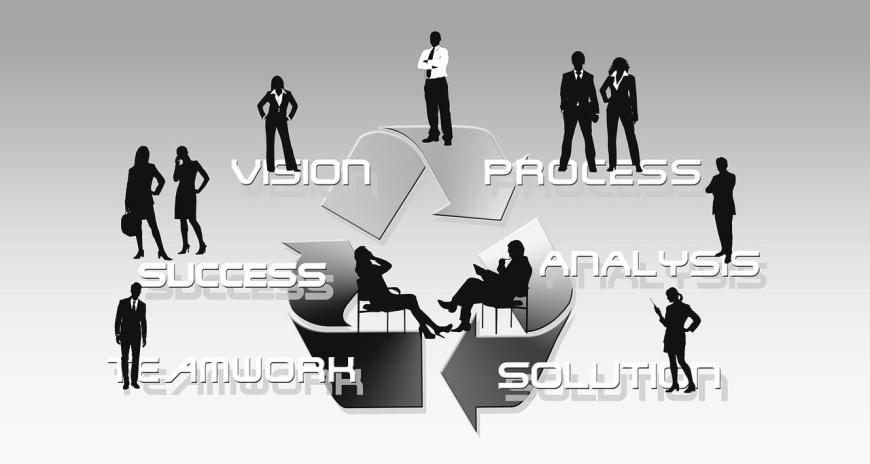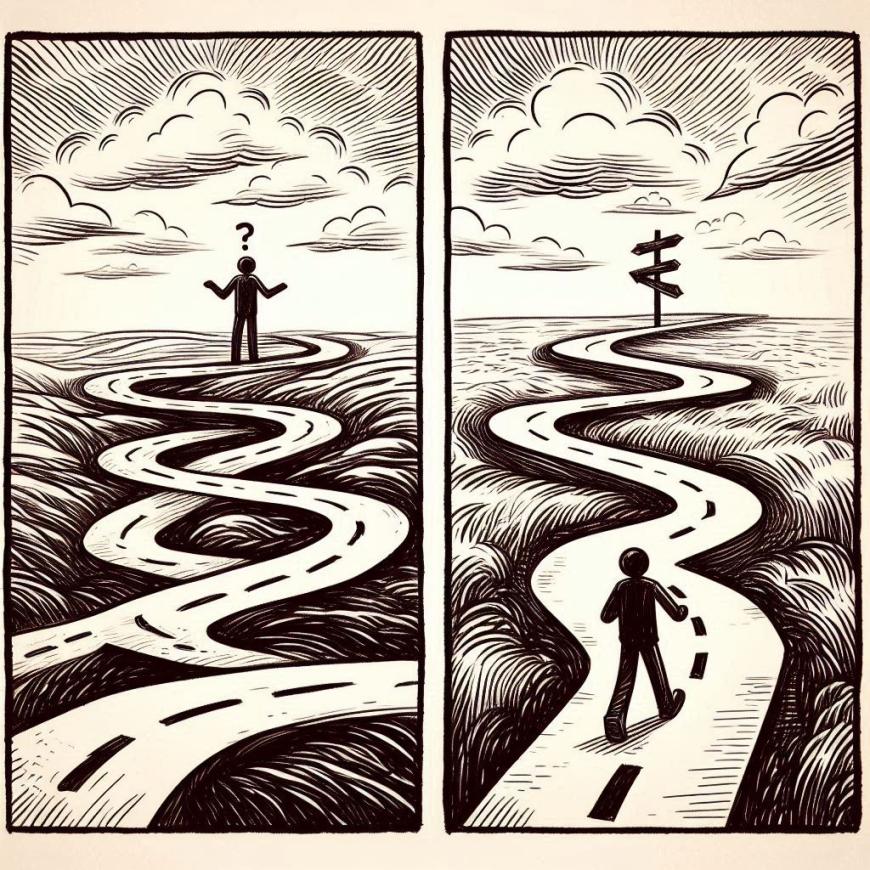- 1. The knowledge that lies within
- 2. Introduction
- 3. The product vision
- 4. Staying true to the product vision
- 5. Note down relevant information
- 6. Validating pain points
- 7. Measuring the right metrics
- 8. Dealing with uncertainty
- 9. Overlapping roles
- 10. Ethics
- 11. Conclusion
- 12. Related insightful articles and a book
Read time: 16 minutes
1. The knowledge that lies within
Are you ready to revolutionize your perspective on product mindset? At ASSIST Software, we believe in the power of a product-driven approach. This article provides essential insights for individuals seeking to develop a strong product mindset.
Discover how to:
- Develop a compelling product vision aligned with customer needs.
- Navigate the complexities of iteration-led versus vision-led approaches.
- Create effective product roadmaps that guide your team towards success.
- Uncover and validate true user pain points to inform product development.
- Measure the right metrics for actionable insights.
- Navigate the challenges of uncertainty and make informed decisions.
- Foster a collaborative and ethical product culture that benefits your organization and its customers.
There won’t be an in-depth description of frameworks, methodologies, or best practices, as this level of detail won’t be useful for beginners, and adhering to a strict how-to would be limited in real-life scenarios because variations do exist, and adaptation is very important. Furthermore, there are plenty of free and paid resources that describe these processes and present them as best practices in the domain.
A good book that I read recently is “Radical Product Thinking” by Radhika Dutt, and this article combines insights from the book with information from various blogs, knowledgeable colleagues, and my short personal experience compared to other giants in this domain.
2. Introduction
Everyone has a different background, and this is the great superpower each of us has. However, this might also be the kryptonite that stops us from stepping on the product road. Whether we are talking about a designer, a developer, or other roles that aren’t part of the IT sector, everyone has their part in bringing success to a product. Furthermore, each one of us can exercise our product mindset, raise our knowledge base and attitude, and enhance the team we are part of.
3. The product vision
Everything can be thought of as a product, even something as simple as a cup of tea. This product is made up of herbs, the mug, the kettle that provides the water, and the boiled water. Each of these components is a product in its own way, even though they are very different. Every one of them is created separately, having in mind the final product (so there is a vision), the end user (the customer has its special place), and potential uses with other products (integration). For every object or service, one can put on a “Product Thinking Hat” and think from this perspective. Through practice, everything comes naturally.
Every product starts as a vision, even if it is not the greatest vision ever heard. In general, a vision that needs improvement:
- is not very clear about what needs to be done and what is to be achieved;
- does not create a sense of purpose.
A good vision is:
- centered on a problem that needs to be resolved;
- tangible;
- meaningful for the end users.
For those who like to delve into methods, a starting point is to look up the 5w1h method and the 5 Whys techniques to clearly identify and state the problem and create a good product vision.

For me, a good vision is not one that everyone recites like poetry, but one that the stakeholders internalize, and everyone can describe it using their own words. We can say that they share the same vision at that point, so they are working with pleasure towards achieving it.
I recall a story a teacher once shared about three bricklayers working on a scaffold. The first worker, who was crouched, was asked what he was doing. He answered that he was cutting bricks into certain shapes and sizes. The second one, who was half standing, was asked the same question. He answered that he was building a wall. The third one, standing tall and working the most efficiently, was asked the same question. He replied that he was building a cathedral. This story, for me, is a powerful example of what a good vision provides.
Think of this article as a product. Its purpose is to guide individuals on their journey towards a product-driven mindset. Unlike many resources that overwhelm readers with complex frameworks, this article offers a clear and accessible introduction. It serves as a stepping stone towards more specialized content, reassuring readers that uncertainty is natural and adaptability is a valuable attribute.
4. Staying true to the product vision
Having the vision stated, the team can track the progress and identify slight detours from the vision to address pressing needs. Now, with a clear scope in mind, every decision is easier to tackle. The following image is a visual representation of what a clear scope does.

In the first panel, we have a figure that went down many roads and is unsure about the destination. In the second panel, we have another figure that is walking along a well-defined path and making informed decisions at junction points. This is like having a blurry vision that increases uncertainty versus having a clear vision with a clear action path. Every road seems good enough if you don’t know the destination.
4.1 Iteration-led vs vision-led
As described in the book “Radical Product Thinking,” companies can be split in many ways, one of which is iteration-led or vision-led.
Iteration-led development builds towards a local maximum. Considering immediate customer needs, versions of the products are created to better satisfy end users. From version to version, the product improves however, there are some limitations of this approach:
- End users don’t necessarily know what they want. This means the product might solve only part of their problem;
- Adding features without a clear direction might create a big product that does a bit of everything but is slowly drifting away from being simple and efficient.
Later, we will tackle the topic of customer-driven versus customer-led approaches to better explain each of them and how they differ. Keep in mind that these are the names used in the book, and variations exist depending on the source, but the concept behind them is what matters the most.
The vision-led approach drives the product towards the global maximum. Reaching the global maximum means solving the end users’ problem in the best possible way, given the current circumstances. However, to be able to reach the global maximum, slight detours might be necessary, especially due to financial issues that need to be resolved first. Ensuring the financial viability of the product is crucial to sustaining its development and continuing its improvement.
However, iterations aren’t bad. Iterative approaches are very good at gathering frequent feedback and refining a product, but iterations on their own are not enough. Teams must iterate with a clear goal in mind for the products to be meaningful. A vision-led approach with iterations combines the best of both worlds: it leverages continuous improvement through iterations while ensuring that every step aligns with a clear and well-defined vision.
Having these concepts explained, it is clear what a good strategy might include. Furthermore, maintaining transparency is very important so that everyone is aligned about the possible slight detours, reprioritizations, and even restructuring of the product vision. By doing so, the team trusts the direction and shares the vision easily. Everyone will eventually think of one big brain working towards the same goal.
4.2 Product roadmap
A product roadmap is a plan of how a product will evolve over time. Some teams use them to keep track of the product functionalities, highlighting the why of each feature. It also communicates the vision, direction, priorities, and progress of long- and short-term goals.
There are various approaches to creating your product roadmap, depending on its purpose. For example, you might create distinct roadmaps for the development team, for the executives, for the sales department, or external roadmaps, each of them focusing on what is important for these stakeholders.
5. Note down relevant information
Complex problems can be associated with mathematics. Just as complex calculations are best handled on paper rather than in your head, product thinking benefits from a similar approach. A good rule of thumb is to note down as much as possible but keep the clutter in check. Keeping information updated, clear, and organized enhances transparency and team alignment. There isn’t the best way to do it. The best way is the way that works. Experiment and see what works for you and your team. Gathering feedback and being sincere is helpful. If something doesn’t look right, there’s likely room for improvement.

Don’t hesitate to make backups before modifying the diagrams, and have multiple diagrams tailored to the needs of different stakeholders. Developers need more technical details, whereas higher-ups need an overview of the general direction in which things are going. Also, stay sharp because every document will require maintenance, and this takes time. Keep only essential information and requests.
6. Validating pain points
In the product vision section, it was emphasized that the vision should be focused on a real problem that needs to be solved. However, how is a pain point identified? This involves a lot of effort from the Product Team using various techniques such as direct observations, interviews, surveys, creating heatmaps to see where users face difficulties, and so on. These methods help gather both quantitative and qualitative data.
With these methods, there are some things that are important to keep in mind. For example, surveys should be designed to avoid placing mental strain on the end user; they shouldn’t be time-consuming, and they should be easy to answer. Otherwise, users may feel discouraged from completing them, resulting in irrelevant or incomplete responses.
As mentioned in the book "Radical Product Thinking," a real pain point must be validated. This means the issue must be significant enough that the customer is willing to invest in a solution, and it must be confirmed through direct verification. To verify a pain point, one must research and identify the problem and check with the customer if the problem does indeed exist. Reaching the customers involves some effort, but it is extremely important to do. In some cases, such as in business-to-business scenarios, it might be difficult to have access to the customer base of the specific company, so one must resort to a customer representative or another knowledgeable stakeholder who can gather as much relevant data as possible. Keep an open mind to opportunities and try to be as close to the customers as possible.
6.1 Customer-driven vs customer-led
Listening to end users is very beneficial for product development, but only if the right decisions are made. Listening to the end user doesn’t mean doing exactly as they say since they might not know what the best approach for their need is. One may be an expert in one domain, but it’s essential to allow other experts to contribute their expertise as well. This raises the necessity to differentiate between two types of strategies:
- Strategies that are customer-driven where the customer identifies a need, and engineers and relevant stakeholders decide on the best approach to solve the issue;
- Customer-led strategies are where the customer leads the direction of the product, even if it might not be the best approach.
Both are customer-centric ways of thinking, putting the end user first. However, managers, designers, engineers, and other relevant stakeholders must focus on the outcome and strategize so that the need is satisfied in the best way possible.
6.2 Identify the unspoken needs
A need can be identified as a job to be done because an end user uses the product to fulfill a task or a job. However, users may not always fully understand their needs or be able to explicitly articulate them. A parallel example relates to experiencing physical pain: we want it to disappear, but we don’t ask for laborious medical procedures. We need a specific solution, but we might not know what it is, and ultimately, we care more about the outcome than the process. By actively listening, empathizing, and engaging with users who don’t have clear solutions, product teams can uncover these unspoken needs. Through feedback and experimentation, the best solutions can be identified and delivered.
7. Measuring the right metrics
KPIs (Key Performance Indicators) and metrics provide information about the evolution of the product and business. However, not every metric is useful, and improving a single metric won’t necessarily attract more users or guarantee success. Good KPIs and metrics can be categorized as “SMART”:
- Specific: Clearly define what is being measured and why it is important;
- Measurable: Metrics should be quantifiable. Not everything can be easily measured, and using related, easy-to-measure alternatives may result in a false sense of improvement;
- Achievable: Metrics should be realistic and attainable. However, it’s important to recognize that focusing too much on improving a specific metric can lead to unintended consequences.
- Relevant: Metrics should be relevant to the business;
- Time-bound: Measuring how a metric evolves over a certain time frame gives a better idea of the progress that is being made and improvements that can be made.
Some real concerns that arise when using KPIs and metrics are demotivation and technical debt. A KPI or metric should be achievable and time-bound, but to achieve the desired state, the team might be demotivated to set higher standards because of the fear that they can’t perform up to the expectations or might gather technical debt to reach that goal within the time frame. Also, focusing on improving KPIs might distract stakeholders from other important aspects of the product, neglecting what is not being measured. These issues can be mitigated by generating a safe environment where stakeholders can discuss their concerns openly and without fear. Encouraging transparent communication and mutual respect helps address these challenges and minimizes the negative side effects.
7.1 Simplicity over precision
Complex situations don’t necessarily need complex metrics. It is often more beneficial to choose a simple metric over a complex, precise one, even if it means sacrificing some accuracy. Relevant stakeholders that follow that metric should be able to explain it and understand it fully. Ambiguities in what a metric measures and how it works can result in poor decision-making. Instead of thinking strategically, stakeholders might opt to improve the metric without questioning its relevance or accuracy.
8. Dealing with uncertainty
As the saying goes, the only certainty is uncertainty. Absolute certainty about a strategic direction is rare since markets evolve fast, and products must adapt as quickly as possible. Taking this into consideration, a product may need to pivot or take opportunities that deviate from its original vision. While this is not wrong, it is crucial to ensure transparency when discussing any potential shifts from the original vision or adjustments to the product’s strategic direction. Also, every decision taken is associated with a certain degree of risk, and it is futile to try to predict every outcome of every decision. In challenging situations, relying on the team’s expertise and asking for a second opinion can be invaluable for making sound decisions.
8.1 Mitigating the risks
Beginners often face uncertainty. Experienced professionals have a better grasp of their actions and can adapt more easily. While instinct can be helpful, a framework or procedure can be beneficial. Courage and ownership are key, but working without a clear direction can lead to unpredictable outcomes.
Learn from experienced professionals and utilize their knowledge, methods, and frameworks. This can provide structure, insights, and greater certainty. Iterations and proactive risk management are also crucial for mitigating uncertainty and enhancing quality.

9. Overlapping roles
The Product Manager’s role acts as a bridge between multiple roles, uniting various stakeholders. Product is at the intersection of many key functions in an organization and is not limited to Product Managers only. Product Designers have a user-first approach, Chief Marketing Officers have customer-driven insights and other roles that don’t necessarily have “product” in their name still share a product mindset, focusing on solving real-world problems. If you have the mindset of, “I should do this because I have this role name, but I shouldn’t do that because it doesn’t fit my role name”, it might be time to rethink this approach. Developers, for instance, can share a product vision too and ultimately can gain ownership of a product and transition to a more product-based mindset. Anyone can learn more about product thinking, regardless of their role.
10. Ethics
History teaches us that even the best intentions can lead to unintended consequences. Focusing only on positive outcomes can divert attention from the potential negative side effects of a product. Focusing on metrics, such as revenue, user retention, and marketing strategies, can also generate suboptimal decisions for the end users, potentially impacting them negatively. For example, the products we develop might inadvertently increase inequality, foster toxic competition, or hijack end users’ attention rather than enhance their daily lives.
Furthermore, privacy erosion is a hot subject now, especially with the rapid expansion of artificial intelligence. There are many other ethical concerns to consider, but that’s beyond the scope of this discussion. The goal of any great product should be to provide positive experiences for the end user because, ultimately, it will impact the world we live in.
An example of a product first thought of as a great idea is the Internet. It had an optimistic direction, but in time, it encountered problems. Looking back at its origins, the creation of the internet came with a bold vision: “A globally interconnected set of computers through which everyone could quickly access data and programs from any site,” as quoted from internetsociety.org. While this vision has largely been realized, the internet has also faced significant downsides over time, such as misuse by malicious individuals and unanticipated harmful developments.
11. Conclusion
The term "product" is woven into the fabric of this article, but what does it truly mean? It's more than just a buzzword. It signifies a laser-sharp focus on the product itself. For a product to succeed, it must create a tangible impact and solve real-world problems, always prioritizing the end user's needs.
Achieving product success requires a collaborative effort. Engaging all key stakeholders and ensuring their alignment with the Product Vision is essential. Transparency serves as the bedrock of this collaborative process.
This article provides a solid foundation for beginners. Remember, there's no one-size-fits-all solution. The article's brevity allows it to remain adaptable and focused. Consider this as a stepping stone towards a deeper exploration of product management.
12. Related insightful articles and a book
If you, the reader, wish to jump directly to other insightful articles and the book that inspired me when I was writing this article, I’ve listed them below. Even though some were mentioned in this article, I’ve gathered them here for easy reference, along with other relevant resources.
- Radical Product Thinking by R. Dutt. I read it on O'Reilly: Cover | Radical Product Thinking (oreilly.com);
- The 5W1H Method. It was mentioned in the book, but I further studied it here: The 5W1H Method: A Comprehensive Guide - DataMyte;
- The 5 Whys Method. The “5” here is a guideline rather than a strict rule, but it is easier (for me) to associate it with the previous method: 5 Whys - Getting to the Root of a Problem Quickly (mindtools.com);
- The Product Roadmap. I found an interesting guide here: What is a Product Roadmap: 2024 Ultimate Guide (productleadership.com);
- Some further articles that I found interesting that align with this theme:
- Bring Product Thinking to Non-Product Teams (hbr.org)
- Maven: What is Product Sense and How to Develop It
- How to Build a Product Mindset (productschool.com)







